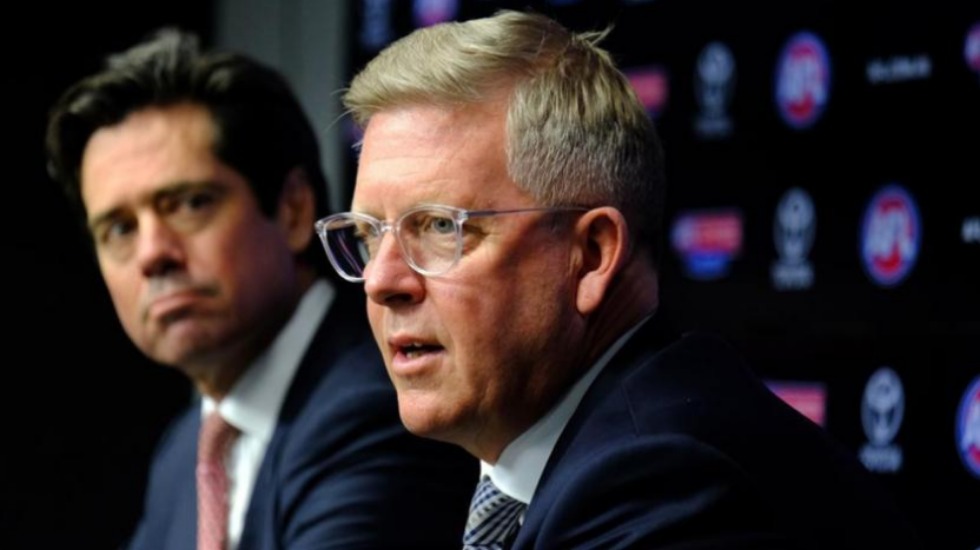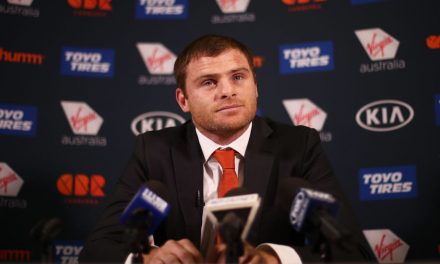Steve Hocking departs the AFL after a short stint as football operations boss to become Geelong’s next CEO. Photo: AAP
You only had to hear Steve Hocking’s line on Monday about how the past couple of years had “felt like dog years to be honest”, to have some insight into the toll taken by the onerous job of AFL football operations manager these days.
Few people in public life, let alone football, have been in the firing line as much as the former Geelong back pocket since he took on the job in 2017, particularly given his preparedness to tamper with the rules of the game in order to return it to the spectacle it once had been.
Whatever you think of those changes, it took some courage to see them through. And, of course, Hocking would remain in an invidious position, those who complain loudest about the state of the game inevitably also those who are loudest in their opposition to changing it.
For what it’s worth, I think Hocking made a pretty decent fist of it. There may have been a little too much tinkering around the edges without getting to the nub of some issues, but given the breadth of his responsibilities, some obvious gains have been made.
Who takes over the job? Brad Scott seems the likely candidate, and has compelling skills and experience in the right areas. Other names being mentioned are Sydney chief executive Tom Harley, West Coast’s football boss Craig Vozzo and Port Adelaide’s Chris Davies.
They’ll need appropriate “danger money”, particularly given the ongoing ramifications of COVID to both the finances and logistics of the entire AFL operation. It’s a massive task, but some priorities remain more important than others.
And the following five areas are where, I think, most of the attention still needs to be focussed.
THE RULES
Whoever ends up Hocking’s replacement, tell them to stop chasing the utopian ideal of high scoring in keeping with the sort of tallies we saw in the 1980s and ‘90s. It’s not coming back. Defence and coaching strategies are too good now for things to change short of reducing numbers on the field.
The better news, though, is that a combination of the “man-on-the-mark” rule, the 6-6-6 rule and reduced interchange rotations have at least started to have an impact in opening up the game.
Proof? An average 56.2 ball-ups and throw-ins per game this season, the lowest figure since 2008, and down from 70.7 in 2015. Perhaps even more importantly, end-to-end football is gradually returning, the rate of defensive-50-to-inside-50 chains of possession is currently at 21.3 per cent, the highest figure since before 2015.
So, can the opening up be expedited further without such drastic measures as zones of 16-per-side? Yes, in my view. And with a pretty simply, unobtrusive mechanism.
That is, have the umpires call for a ball-up far quicker than they do now. In short, a return to the “old days”, where play would be halted and the umpire re-start when any more than three or four players were fighting for possession and the ball not coming out immediately.
It would clear the area quicker. It would make players realise clustering like bees around the honeypot was futile, and instead head away from the scrimmage and towards the next likely possession.
The other key area of focus for the new appointment where rules of the game are concerned should be the holding-the-ball interpretation.
Currently, it’s a mess, inconsistently applied and with the balance having tipped way too far in favour of the player in possession. Not surprising, as the law as it stands has five different sub-clauses including the ubiquitous “prior opportunity”.
It shouldn’t be nearly that complicated. So clean it up, simplify it, make it more of an instinctive judgement about whether a player with the ball had his chance to get rid of it, and whether the tackler applied a good enough tackle to earn a reward.
And holding the ball is merely an example of the extent to which umpires have been saddled with too many considerations. It’s starting to interfere with their calls in more routine run-of-the-mill game situations. And in a game so dependent upon interpretation, that, too, is futile.
So let them interpret more. That would surely help promote talented umpires with a genuine feel for how the game should be played, and less prone to blow the whistle to a set of fixed commands.
PLEASE HELP US CONTINUE TO THRIVE BY BECOMING AN OFFICIAL FOOTYOLOGY PATRON. JUST CLICK THIS LINK.
THE JUDICIARY
Hocking sought to simplify further the AFL’s judicial process by dispensing with the Match Review Panel and leaving the task to a sole Match Review Officer, Michael Christian. That has helped to reach verdicts more swiftly and avoid day upon day of media speculation about less savoury aspects of the game.
The downside has been that with the entrusting of important decision-making to one man, the AFL football operations boss has been more likely to either have more informal input into the verdicts reached, or, as was the case with Adelaide’s David Mackay, override the role of the MRO.
The AFL shouldn’t have it both ways. If you have enough faith in one man to reach the right verdicts, let him do so, with the Tribunal still there as a review body if clubs believe an injustice has been done.
The league for a long time prided itself on the tribunal’s independence. That perception has been severely compromised by wading into matters when it doesn’t like a particular verdict. And at a time when the public at large sees the AFL as way too prone to brokering deals and compromising process, it should be enshrining the autonomy of the judicial officials, not undermining it.
THE WELFARE
Concussion remains the elephant in the room in AFL football. More obvious now, but still something of a sleeper in terms of potentially havoc-wreaking class actions from former players whose cognitive capacities have been damaged by poor treatment of serious head injuries.
Given that context, you can understand the AFL’s sensitivity around the issue and its legal ramifications, hence the rush to introduce the medical substitute right on the eve of the new season.
It’s been a messy business, though. There’s been too much scope for manipulation once the parameters were expanded from concussed players to anyone deemed “seriously injured”, the supposed exclusion for 12 days for those subbed out not hard and fast, and the fact players not even activated as 23rd player are still credited with a game downright silly.
A fair bit of tidying up is in order.
THE AFLW
No one can dispute how far the AFLW competition has come in just five seasons, the standard of play immeasurably better than when it began in 2017, no mean feat when you consider how many more teams will be part of it in the 2021-22 season than in season one.
Interest is high and growing, despite some at-times lukewarm commitment towards the competition from mainstream media and on occasion, seemingly, even the AFL itself.
The greatest anomaly, though, and it’s a big one, is that next season, there will not be a single female coach of an AFLW team, despite the fact Bec Goddard led Adelaide to that very first AFLW flag. Ironically, July is the AFL’s “Women’s Coaching Month”, “promoting coaching as a pathway for women and girls in the football community.”
Hocking’s successor needs to be actively pushing the promotion of women to senior roles within the competition, lest initiatives like this one come across merely as lip service to what should be an integral part of the football mix.
THE VICTORIAN STATE LEAGUE
What is it, exactly? It’s still called the VFL, but now consists of 22 teams, seven of them Victorian AFL club reserves teams, another two affiliated with AFL clubs, seven more stand-alone Victorian teams, four reserves teams from GWS, Sydney, Brisbane and Gold Coast, and two stand-alone Queensland teams, Southport and Aspley.
It might have made the logistics of preparing AFL-listed players for senior action easier for the AFL, but using as something of a lab experiment (including trialling rules) what, prior to 1995, was a proud competition rich in history called the VFA, has done nothing for fans other than create a competition nobody in particular cares much about.
All that does is perpetuate the belief that only one football competition matters. And you can apply the same level of disinterest to the other state leagues, and indeed suburban and country football as a whole.
Hocking’s replacement has some big jobs on their hands, but this one is no less important. It’s about restoring a sense of belonging to supporters increasingly held at arm’s length from the game they love. And that means treating the lower tiers of the game with a lot more respect.
This article first appeared at ESPN.











